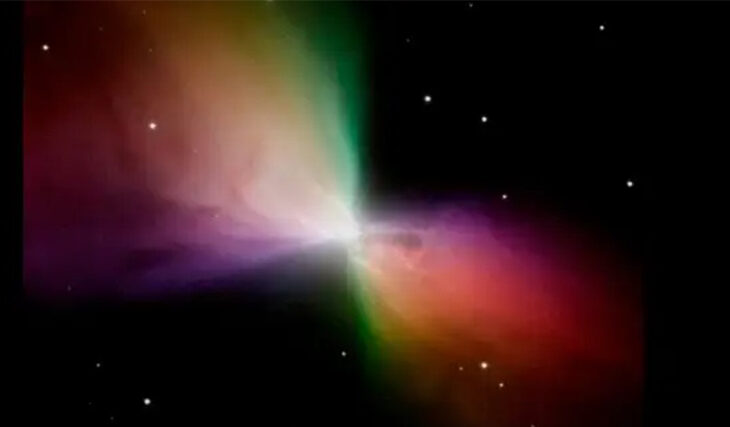A color-coded image of the Boomerang Nebula, as taken by the Hubble Space Telescope. The gas expelled from this star has expanded incredibly rapidly, causing it to cool adiabatically. There are places within it that are colder than even the leftover glow from the Big Bang itself, reaching a minimum of about ~1 K, or just a third of the temperature of the cosmic microwave background.
About 14 billion years ago, at birth, the Universe was heated to a whopping 1032°C. Now its main property is cold.
The coldest place on Earth
The South Pole has long been the absolute record holder for low temperatures, the Russian Vostok station in Antarctica. On July 21, 1983, the lowest temperature on the planet in the entire history of meteorological observations was recorded here: -89.2 0C. The average temperature in summer is -35.5 0C.
This is very different from the temperature in, for example, Greenland. The lowest temperature was recorded at the Northern Ice research station on January 9, 1954 -66.1 0C.
Credit: Joe Mastroianni/National Science Foundation, via Wikimedia Commons
In North America, the frost record belongs to the Canadian settlement of Snag: on February 3, 1947, it was -63 0C.
In Europe, the coldest place is considered to be the village of Ust-Shchugor (Komi Republic, Russia). Just before the New Year – December 31, 1978 – residents received a “harsh” gift: frost with a temperature of -58.1 0C.
But this is nothing compared to the cold in space.
Cold Places in the Solar System
It would seem that the further from the Sun, the colder it is, and this is only partly true. The three coldest places include Neptune’s satellite Triton -459.68 degrees Fahrenheit (not higher than -237.6 0C), Pluto -446 0F (-230 0C), and the Moon -4100 F (-250 0C) or 25 K.
Why it is so cold on Triton is clear: 4.5 billion kilometers from the Sun. Pluto is colder than it should be because nitrogen ice on its surface melts as the planet approaches the Sun and forms again as it moves away. As a result, the surface cools down like the body of a sweating person.
The Moon became a record holder due to deep craters, the bottom of which cannot be reached by sunlight. Moreover, its surface can heat up to more than +100 0C.
Cold objects in space
White dwarfs are the remains of burnt-out stars and are among the coldest. Their temperatures can reach several thousand degrees Celsius, which is relatively cold for stars and very hot for some regions of the interstellar medium. Bright areas and the intercloud medium are heated to 10,000 degrees K, while molecular clouds and nebulae are only 10-20 degrees K. For example, the Barnard cloud, where temperatures can drop to -423 0F (-253 0C), contains dense clouds of gas and dust.
During its existence, the Universe cooled. The background radiation left over from the Big Bang is only about -270.3 0C (-454.8 0F) or 2.7 K. It has a Black Body spectrum – as predicted by the Big Bang theory.
But how did they measure the temperature there in space?
Measuring temperature in space
For nearby planets such as Mars, atmospheric research can be done by sending probes directly from their surface. But when it comes to distant planets such as Neptune and Uranus, we face enormous distances and difficulties in sending probes.
Instead, we decipher the characteristics of these planets, including their temperatures, by analyzing the light that comes to us from them. This light provides information about the composition of the planet’s atmosphere, so we can accurately determine its temperature. The molecules and atoms in a planet’s atmosphere essentially create a unique “temperature fingerprint.”
The Boomerang Nebula has the coldest such imprint.
Severe frost of the Boomerang Nebula
The Boomerang Nebula is 30 million billion miles away and has a temperature of about minus 457 degrees Fahrenheit (minus 272 degrees Celsius).
This temperature is close to absolute zero (-459 degrees Fahrenheit or -273 degrees Celsius), at which particles and atoms stop moving. This means that it simply cannot get any colder. The Boomerang Nebula is one of the coldest places in the Universe, more than three times colder than Antarctica’s Fuji Dome in 2010 (-199.8 0F or -93.2 0C).
The Boomerang Nebula is so cold that it is even colder than the cosmic microwave background, and light from the CMB is absorbed by the nebula, as noted when it was discovered in 1980.
Space refrigerator
The Boomerang Nebula contains a red giant star in the final stages of its life. In the future, the star will become a white dwarf, and the nebula itself will turn into a planetary nebula.
Despite the presence of a red giant, the Boomerang Nebula remains extremely cold. This is because gas from the red giant is expanding outward at a speed of about 164 km/s, and its rapid expansion in space results in the nebula’s abnormally low temperature. This expansion of gas is similar to the operating principle of a refrigerator.
Research with the ALMA radio interferometer in 2013 found that the visible part of the nebula is surrounded by a large volume of cold gas, visible only at submillimeter radio waves. The outer edges of the nebula are gradually heating up.
How was this discovered?
In 1980, astronomers Keith Taylor and Mike Scarrott began exploring the Boomerang Nebula using the Anglo-Australian Siding Spring Observatory Telescope. At that time, they did not yet know that this would be the coldest place in the Universe, but its shape resembled a boomerang, which served as a natural name.
In 1998, the Hubble Space Telescope took more detailed images of the nebula, and its shape became more like a bow tie or hourglass. But astronomer Raghvendra Sahai had previously predicted the existence of cold regions in a paper published in 1990 in the Astrophysical Journal.
Sahai suggested that the wind from the star could rapidly expand, causing a sharp drop in temperature and turning the star into a kind of cosmic refrigerator. In 1995, his team, using a submillimeter telescope in Chile, tried to test this theory on the Boomerang Nebula, which led to the determination of its extremely low temperature.
Work by Raghvendra Sahai at NASA’s Jet Propulsion Laboratory (JPL) showed that the low temperature of the Boomerang Nebula was caused by the rapid release of gas. He suggested that the dying red giant might have collided with a small companion star, causing a massive release of gas at extreme speeds.
This process explains the unusual characteristics of the ultracold nebula. What is also important is that the gas is released through a tiny hole, which speeds up its cooling.
Records of cryogenic laboratories
In outer space laboratories, special cooling systems can achieve temperatures close to absolute zero (-273.15 0C or -459.67 0F).
What about the coldest place on Earth?
In 2015, a group of physicists at the Massachusetts Institute of Technology cooled atoms to the coldest temperature in human history: 500 nano kelvins – that’s minus 273.15 0C. It’s much colder than the Boomerang Nebula. The researchers used lasers to cool individual sodium and potassium atoms.
However, the lowest temperature to which the substance has been cooled is 38 picoKelvin (-273.149999999962 0C, or -459.6699999999316 0F), which is only 38 trillionths of a degree above absolute zero (0 Kelvin; -272.15 0C; -459 .67 0F). This temperature was achieved by a group of researchers from the QUANTUS Team (DEU) in Bremen, Germany, in August 2018. The results were published in the journal Physical Review Letters on August 30, 2021, and this result is listed in the Guinness Book of Records.
Banner image:
NASA, ESA and The Hubble Heritage Team (STScI/AURA)
Image credit:
https://bigthink.com
https://futurism.com
https://www.esa.int
https://surfacetreatments.infn.it

